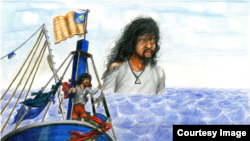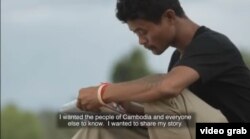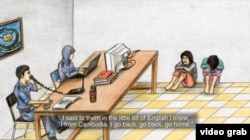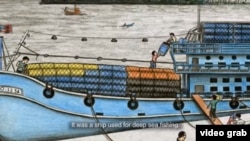After escaping from modern slavery on a Malaysian fishing vessel and in a palm oil plantation in 2010, Prum Vannak, an artist from Battambang province, has published a graphic memoir of his experiences as a victim of human trafficking.
Vannak partnered with Australian film director and co-author Jocelyn Pederick to tell the story of “The Dead Eye and the Deep Blue Sea”, which was published by Seven Stories Press in June 2018.
The book follows Vannak’s journey from crossing the Thai border illegally seeking work to being kidnapped, tricked, and sold into forced labor and involuntary servitude. The book also serves as a warning to Cambodians and the rest of the world that neo-slavery on the sea exists.
It has been about nine years since Vannak was rescued by a human rights organization and sent back to Cambodia from Malaysia, but he said his memory of his time at sea is a wound that will never heal.
"I could not forget that, and I opt for doing housework and drawing to detach myself from that bad memory," he said.
Life on the Fishing Boat
In 2006, hoping to secure enough money for his wife to safely give birth, Vannak, crossed the border illegally anticipating he could get a job in Thailand. But he was tricked and sold to work as a slave on the fishing vessel for three years and seven months.
According to Vannak, the laborers on the vessel were from Cambodia, Thailand, and Myanmar, and people were communicating in Thai. The laborers were classified into two categories: the salaried men who could return home, and the unpaid men who were held against their will. Vannak fell into the latter group.
"For those who paid tax [employment fee], they got a salary and could return to the land, but for those who have been sold like us, [we] could not get a cent," he said.
He added that on the vessel two or three meals were served per day, always seafood. Once in a while the workers could have chicken or pork.
But the food was the least of his worries, as he was made to work up to 20-hour a day, allowed little sleep, and suffered under the crushing weight of violence used by the vessel's manager and the security crews on the workers, or between one worker and another.
"Violence is used when we fail to follow orders and they targeted [slave] workers," he said. "The boat was full of conflict, fights, and murders", he added.
Vannak said when a worker fell ill, the manager kept their eyes on them for a few days. If they could not recover, they would be beheaded, or tossed into the ocean.
Workers outnumbered the manager and the security crew, but they could not fight back because they were placed with different nationalities to limit communication.
To avoid being slapped or punched by the manager or the security crews, Vannak chose to do extra tasks like sweeping the boat or watering it when the weather was hot to prevent the boat from cracking. Likewise, to protect himself from other workers, Vannak tried to maintain a good relationship with them by giving them free tattoos. He produced tattoo ink by mixing toothpaste and coal.
Seahorses Used as Currency
Workers could get free methamphetamine from the manager or bought it from small boats coming to collect fish. Money was not used in the trades. Instead people used dry seahorses as currency, which are used in traditional medicine on the land. Vannak said workers used the sea creature to trade for drugs, liquor, cigarettes, snacks, or soda. Seven seahorses could trade for a bottle of wine, five for a pack of cigarettes, four for a snack or a bottle of soda.
Vannak and other workers hid small seahorses when they found them and kept them for trading. If they found bigger seahorses, they were supposed to give them to the manager. But most of the time when the manager saw the workers with seahorses, they would take them.
Crocodile in Water, Tiger on Land
The situation on the boat became unbearable for Vannak, so he and the other workers planned a midnight escape by jumping into the water with a box of fish sauce each and swimming to the shore when the boat was about 4 or 5 kilometers from the coast. He tied one hand to a fish sauce container to provide buoyancy and another to a knife to cut fishing nets and to protect himself from sharks. With the help of the current they managed to reach the shore after about 20 minutes.
After reaching the shore, they ran into the forest and stayed there for the night. The next day, they met a Thai who transported them by boat to the local police station. But the tragedy did not end there as later the police brought them to work at a palm oil plantation. Vannak assumed that they were sold by the police because he saw the police accept money from someone at the plantation, he says.
According to Vannak, several months later he was hospitalized after being attacked by a Myanmar worker who had also attacked another Khmer worker Vannak was trying to help. At the hospital in May 2010, he was rescued by a human rights organization and sent back to Cambodia. His wife thought Vannak had died as he had not contacted home in more than four years
Book Tour in the US
The authors will go on tour in New York (May 7-12), Washington DC (May 12-17), and Los Angeles (May 18 -21) to promote the book.
"The publisher, Seven Stories, has given us an opportunity to come to the US so that Vannak can talk to people about his story, share his story, and promote the book to the American audience,” said Pederick.
“So, our hope is that people hear his story and are interested in buying the book. And I suppose in addition to that we learn about the issue of men who are working on the vessels in Southeast Asia,” she said.
The book was used as a textbook in the course of Art and Psychology at the University of California, Los Angeles.
"There has really never been a book made like this, and certainly one that is told from the perspective of a survivor and illustrated with detailed illustrations. So it is a very unique story and we have been really overwhelmed with how well the book has been reviewed," she added.
Although the book is only available in English initially, Vannak hopes Cambodian readers can understand the story through his drawings. Pederick said Vannak spent almost four years finishing the illustrations and the book took more than six years to get published. She hopes she can get some funding from sales of the book or find a partner in Cambodia to translate the book into Khmer in the near future.
The Effort to End Slavery
In 2012, Vannak was named as one of the State Department's Trafficking in Persons (TIP). He received the award directly from Hillary Clinton, the former presidential candidate and secretary of state.
Vannak has vowed to work to reduce the number of human traffic victims and hopes the book will help. Through the book, he wants to warn readers about the risks of illegal migration, the underhanded tactics of traffickers, and the miserable experiences he encountered as a modern slave on the vessel. He hopes that his story will stop those who are about to cross the border illegally. Vannak noted that he does not want anyone to follow his footsteps.
In the future, he wants to become a journalist and work with human trafficking victims.
Although Vannak has his freedom, his family's income is still low. He has no full-time job. He now lives in Battambang with his family and works as a freelance artist. His wife stays at home looking after their two children, a sixth grader and a third grader.
Since the ordeal, he has never wanted to visit or travel to Thailand or Malaysia. He wants his two children to be highly educated so that they will get good jobs in the future, so they won’t be incentivized into becoming an undocumented migrant worker as he did.








